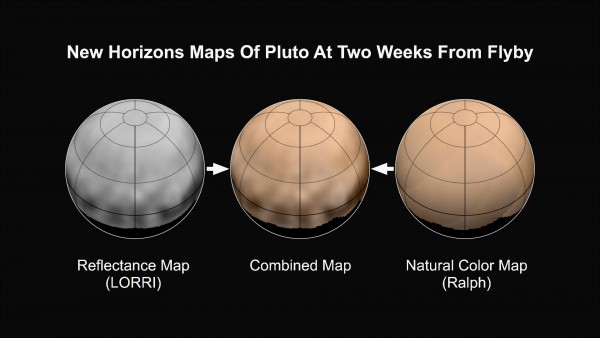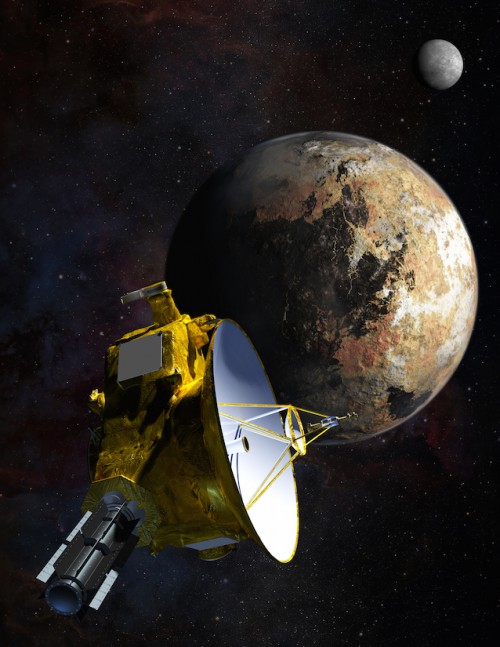
After an anomaly was detected onboard the New Horizons spacecraft on July 4, which had many people holding their collective breath, NASA announced today that science operations will resume on July 7, just days before the spacecraft makes its closest approach to Pluto and its moons on July 14.
This is good news of course for a spacecraft which otherwise continues to be in excellent health. The flyby of Pluto will be the first time in history that this fascinating dwarf planet and its moons have been seen up close.

“I’m pleased that our mission team quickly identified the problem and assured the health of the spacecraft,” said Jim Green, NASA’s Director of Planetary Science. “Now – with Pluto in our sights – we’re on the verge of returning to normal operations and going for the gold.”
The anomaly caused the spacecraft to go into “safe mode” on July 4, and contact with New Horizons was temporarily halted. The mission team has now determined, however, that there was no hardware or software fault involved, but instead “the underlying cause of the incident was a hard-to-detect timing flaw in the spacecraft command sequence that occurred during an operation to prepare for the close flyby,” according to the update. Also, no further similar commands are planned before the closest approach.
During the time that contact with the spacecraft was lost, the autonomous autopilot onboard recognized a problem and—as it’s programmed to do—switched from the main to the backup computer. The autopilot placed the spacecraft in “safe mode,” and commanded the backup computer to reinitiate communication with Earth.
There will be no significant impact on the mission; science operations will resume on July 7 and the flyby sequence will continue as planned. The mission science team and principal investigator have also concluded that the science observations which were lost during the anomaly recovery period will not affect any primary objectives of the mission, with only a minimal effect on lesser objectives.
“In terms of science, it won’t change an A-plus even into an A,” said New Horizons Principal Investigator Alan Stern of the Southwest Research Institute, Boulder.
Diagnosing such problems takes time, since New Horizons is currently almost 3 billion miles away. Even at the speed of light, radio signals take 4.5 hours to reach Earth, meaning two-way communications require nine hours in total.
Apart from the anomaly, there have been no other problems or potential hazards. The mission team has determined that there are no rings or other small undetected moons (apart from the five known ones) which could endanger that spacecraft. With only a few days left until closest approach, the all-clear has been given for the flyby to proceed as planned.

The newest images of Pluto and its largest moon Charon are continuing to show more and more surface detail, including four odd dark spots along the equator on Pluto, which appear to be about the same size—about 300 miles across each—and more or less equally space, according to mission scientists. Newer images during the next few should help scientists to determine what they are. There are also high-contrast albedo variations on Pluto’s surface, giving it a very mottled appearance. Pluto is already known to have an active surface, where the thin nitrogen, methane, and carbon monoxide atmosphere regularly freezes onto the surface as ice and then sublimates again. It is also thought that Pluto “shares” its atmosphere with its largest moon Charon during this process, something not seen between two planetary bodies before.
The new images being sent back are already amazing, but the ones from closest approach will be much, much better still. We are now on the verge of finally seeing this world as it really is; after traveling through the Solar System since 2006, the closest approach to Pluto by New Horizons is now only eight days away!
See the New Horizons website for more information about the mission.
Stay with AmericaSpace for regular updates and LIVE COVERAGE of New Horizons’ approach and flyby of the Pluto system.
Be sure to “Like” AmericaSpace on Facebook and follow us on Twitter: @AmericaSpace
Missions » New Horizons »



Could the delay have been created to give the NSA, NASA and JPL time to review anomlous structures on the planet?
Oh PAHLEEEEZE! :-/
Really, guys? Troll is in her name, for crying out loud.
DO NOT FEED.
‘The delay created?’ Wow, we have a conspiracy nut!
‘John the Billy Goat’? Could Johnny be a Chicago Cub Fan for crying out loud?
Also have any of you seen any new pictures of the Ceres Mining equipment next to the White Spots?